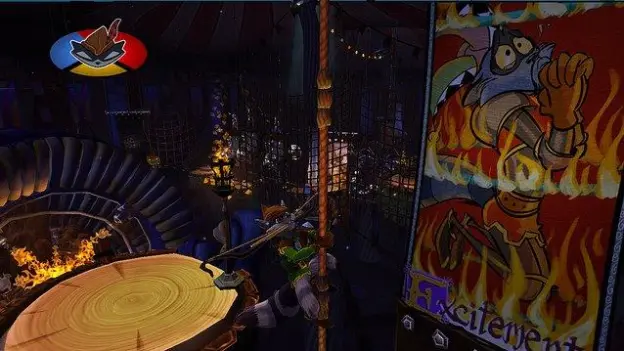“Excellent platforming meets near perfect cross-play”
- The cross play between Vita and PS3 is nearly flawless
- Smooth platforming
- Colorful designs
- Too many missions are filled with familiar tropes
- Borrows heavily from other games
- Stealth mechanics are subpar

When it comes to the motion picture industry, it does not traditionally look kindly on Q1. There are a handful of Academy Award nominees that receive wide release after dipping their toes into the previous year to gain eligibility for voting, but for the most part this time of year is a dumping ground for Hollywood. It is the time of year when delayed films are finally released, and stars looking for a comeback without much competition gravitate to. The budgets are low, and the expectations aren’t much higher. That same cannot be said for gaming, at least not recently.
In the past, Q1 was where games were sent to die. Missing the holiday season is a big deal, and so games released in January were generally there to get them off the books of publishers. They needed them released, and didn’t care when so they went to Q1. That has changed recently. Publishers and developers are now seeing Q1 as a potentially lucrative quarter. There are several reasons for this, including the simple fact that it is still winter in North America, and gamers – like most sane people – are more likely to hang out inside. Last year saw several blockbuster releases around this time, and both Nintendo and Sony released their most recent handheld systems in Q1 – the 3DS in 2011 and the Vita in 2012. And this year Q1 is even more crowded.
We’ve already seen a few big releases like Dead Space 3 and DmC: Devil May Cry, and before the quarter is complete we’ll have a new God of War, Crysis 3, BioShock Infinite, and many more. Part of that is due to the new love affair publishers have with Q1, and part of it is almost certainly related to the pending announcement and subsequent releases of the next Xbox and PlayStation, probably around Thanksgiving. There has yet to be a single game announced for Q3 and Q4 (with the exception of Grand Theft Auto V in September, which is the result of a delay). Once the new systems are unveiled, there will certainly be a flood of titles for the next gen, but that leaves developers with the titles they are currently working on for this generation and need to get on shelves before the next gen titles steal all the excitement. But with all the big name releases coming this winter and spring, there are bound to be a few that are lost in the shuffle, including Sly Cooper: Thieves in Time.

Studio Ghibli This Ain’t
If you expect a brilliant story, complex character motivations, and enough political intrigue to make George R. R. Martin smile, you’re going to be starkly disappointed by Sly Cooper: Thieves in Time. The story found in Thieves in Time is just not a work of art, but then again it’s also not supposed to be. Instead, it’s more fitting to compare the game’s plot to those found in the animated films released by Dreamworks. You know they’re usually going to lag behind the best in the industry, but they can still be quite enjoyable (especially if you’re a child). Sly Cooper: Thieves in Time is exactly the same way. The game’s plot is riddled with clichés and humor that will best play to a younger audience, but if you know that going in you won’t be appalled by it. In sum, the story in Thieves in Time is a largely harmless excuse giving developer Sanzaru Games the freedom to include any manner of gameplay within the title.
The quick and dirty, no spoilers version of the tale is that Sly, Bentley and Murray are sent back in time to restore the past. A villain has discovered a way to permanently erase Sly’s ancestors from history, so in a solution that directly references Back to the Future at least twice the trio travels through time to save Rioichi Cooper, Sly’s distant cousin from feudal-era Japan.

Thanks to the aforementioned clichés, it’s easy to fill in the rest of the game’s plot based on that short synopsis. Rioichi, as you’d expect, is both a ninja master and a sushi chef. Ancient Japan is populated largely by anthropomorphic animal versions of samurai, ninjas, martial arts experts, and any other stereotypical figure you might find in an Akira Kurosawa film. Not that developer Sanzaru Games took the lazy, paint-by-numbers approach to the world of Sly Cooper: Thieves in Time. Though the firm made sure to populate its game with common, expected faces, that’s merely an effort to make the environment relatable. The attention to detail Sanzaru infused the world goes with beyond these stereotypes however, and proves that a ton of love went into the creation of Thieves in Time.
Given the family-friendly aim evident in Sly Cooper: Thieves in Time, there’s absolutely no reason that Sanzaru Games had to accurately depict things like period-specific coinage of its otherwise totally fictional vision of Feudal Japan, but it stands as a quality example of how this game is not just a great title for the kids, but is also perfectly capable of entertaining their parents or older siblings – a feat made doubly impressive by the lack of gore and busty female characters in Sly Cooper: Thieves in Time.
The Interactive Cartoon Cliché
Every visual element of Sly Cooper: Thieves in Time is presented in a lovely cel-shaded style, similar to that seen in Nintendo’s The Legend of Zelda: The Wind Waker, only with more detail. Like that game, the color palette employed is full of bright colors. Its characters are all crafted with humorous, Looney Tunes-esque exaggerated animations, and the basic designs of each level seems crafted to promote clever thinking and quick reflexes over any sort of wanton violence. This goes for both the PlayStation 3 and PS Vita versions of Thieves in Time, though the latter features reduced frame rates and a barely noticeable dip in overall visual detail. Sly Cooper: Thieves in Time, both in form and function, is appropriate for the whole family while maintaining a level of quality and content normally only found in the kinds of hardcore titles marketed to older life-long gamers.
Take, for instance, the most basic gameplay elements of Sly Cooper: Thieves in Time. Though this is undeniably a classic platforming game, it allows players to choose between (at least) three characters who each feature their own distinctive gameplay style. Sly Cooper is, as always, a stealthy thief who relies on his agility and ability to swipe things from unsuspecting foes to complete tasks. Bentley the turtle is the brains of the operation, and while he’s far from acrobatic his technical abilities prove valuable in solving certain puzzles and hacking electronics. By contrast, Murray is the muscle of the group. As a not-particularly-bright hippopotamous Murray doesn’t offer much in the way of brilliant tactics or high-tech gadgets, but he’s more than capable of punching things and throwing huge objects that his colleagues can’t even lift.

This wildly varied cast lends itself to a number of gameplay scenarios – particularly when your crew is joined by Sly’s ancestor Rioichi Cooper. In one mission you may find yourself swiping armor fragments from sleepy warthog guards while avoiding roving spotlights, while in another you could play through an homage to Capcom’s classic shoot ’em up Forgotten Worlds that is far more enjoyable than it has any right to be. Other examples include missions where you’re tasked with simply scouting out a location from a high rooftop, or navigating your way through a top-down perspective maze as a glowing tank while firing off virtual rounds at similarly virtual robots. A few too many of the missions found in Thieves in Time tend toward the classic “collect multiple keys, then find the exit” trope, but for the most part the gameplay variety found in Thieves in Time is unparalleled.
Of course, none of that would matter if Sanzaru Games had screwed up the title’s basics, but happily Sly Cooper: Thieves in Time is as solid a platformer as has ever appeared on a Sony console. Movements are quick, the game’s controls are responsive, and even the most naïve new player will be able to enjoy Thieves in Time after mere moments of getting acclimated to the game. The one issue found in Thieves in Time’s control scheme is the utility of the Circle button. Most often players will use the Circle button to “attach” Sly Cooper to objects in his environment. Think of it as a context-sensitive command that tells the game to interact with whichever piece of scenery is nearest at hand, and in that regard it works flawlessly.
So, what’s the problem? While playing Thieves in Time, it’s hard not to notice similarities between the actions and animations of protagonist Sly Cooper and the lead character in the recent Assassin’s Creed III. In that title the act of catching a railing while leaping through the air or sprinting up a wall to stand on the roof of a building are handled automatically and only require a player to aim his avatar correctly. The result is fluid parkour that stands as the key selling point of the aforementioned franchise, and while it’s not necessarily appropriate to add that system to Thieves in Time in its entirety, the alternative employed by Sanzaru Games renders stealth and movement options in Thieves in Time far less fluid and intuitive than one might hope or expect. It’s serviceable as is, but it could have been better.
Thieves in Time also features one glaring technical issue. When starting a mission on either the PlayStation 3 or PS Vita versions of the game, you’re presented with a loading screen that features handy percentage ratings showing how many of the game’s various collectibles you’ve discovered. The screen is very useful by itself, but it tends to appear for no less than 30 seconds at a time. At the very worst, load times approached a full minute and a half. They aren’t quite egregious enough to kill off all enthusiasm you might have for the next mission, but they certainly drag players immediately out of the mindset they had at the end of the previous stage.

On the other hand, the technology we expected to be the least functional is actually one of Thieves in Time’s most appealing inclusions. As with a number of other recent Sony games, Sly Cooper: Thieves in Time features cross-play compatibility between its PS3 and PS Vita incarnations. Save your game on one platform, use the simple “upload to cloud” menu option, and the next time you want to play Thieves in Time on the other platform, you need only pull the file down from the cloud and continue the adventure where you last left off. It’s exceedingly simple and it just works. If Sony ever wants to pump increased promotional dollars into the ad budget for this cross-play gimmick, Sly Cooper: Thieves in Time would be a perfect example of how it’s supposed to work.
Conclusion
Sly Cooper: Thieves in Time offers great, classic gameplay ideas mixed with colorful, attractive aesthetics, resulting in a light-hearted adventure that parents can give their kids without fear that the game will warp them, either morally or in regards to their personal taste in video games. If you have a kid of gaming age at home, Sly Cooper: Thieves in Time should now be on your must-buy list – doubly so if you’ve ever enjoyed a three dimensional platformer that didn’t include the name of a famous plumber in its title.
Thieves in Time may not be the perfect game, and it does suffer from a few odd design choices, but otherwise it’s one of the best games released so far this year. Yes, we’re only about a month into 2013, but expect that acclaim to remain valid for quite a while. It may not prove Game of the Year material once December rolls around, but Sly Cooper: Thieves in Time will certainly rank among this year’s better games.
Score: 8 out of 10
(This review was written using PlayStation 3 and PS Vita copies of the game provided by Sony.)
Editors' Recommendations
- Homeworld 3 preload guide: release time, file size, and preorder
- Is Sea of Thieves cross-platform?
- Move over, Wordle: The New York Times has a new puzzle game
- PS Plus bolsters its lineup with Deathloop, Sly Cooper, and more
- Wordle is now playable on New York Times Crossword app


